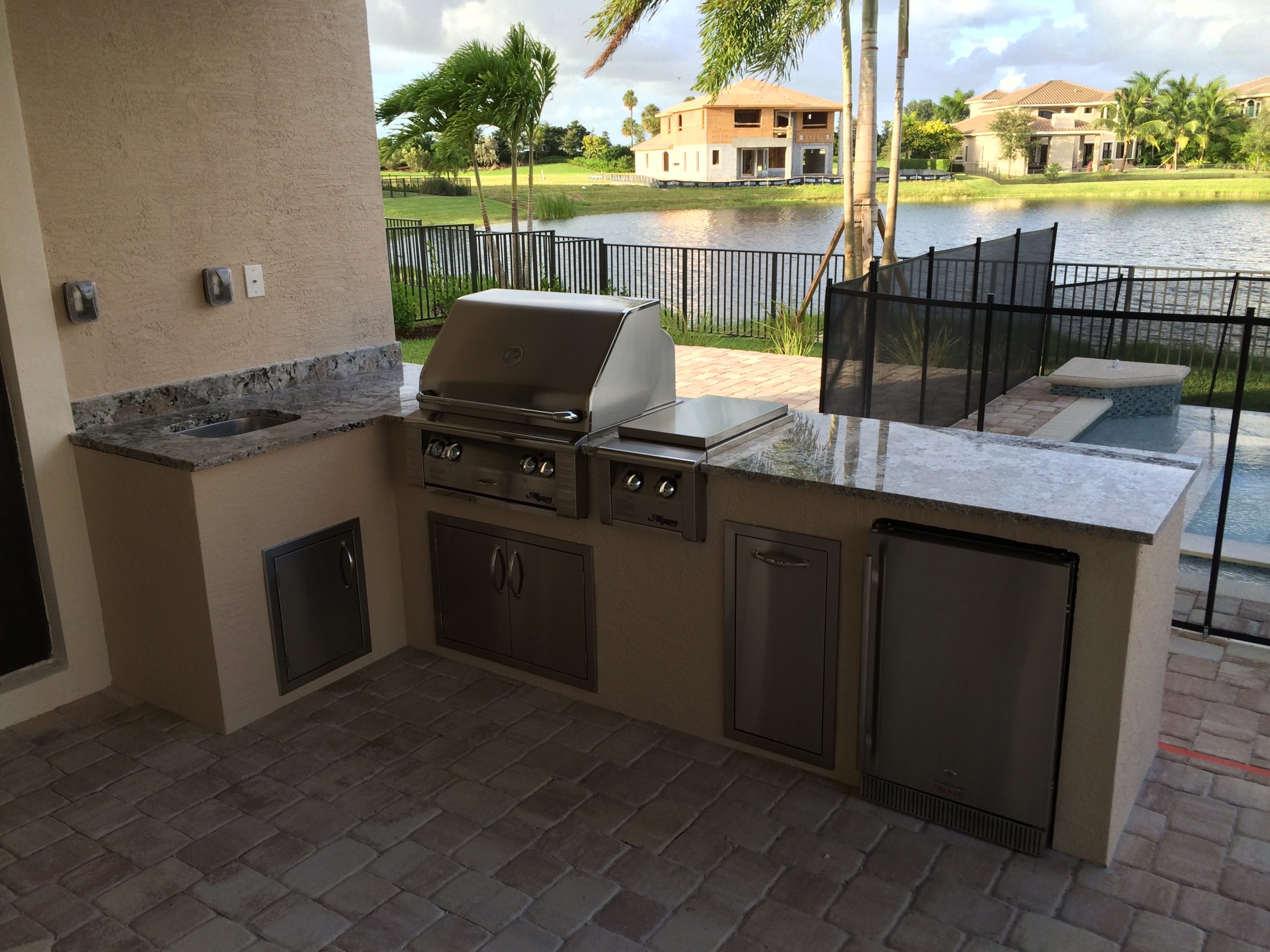Want to create an outdoor kitchen that’s a game-changer for your backyard? Think L-shaped! This layout is perfect for maximizing space while giving you all the essentials you need for cooking and entertaining like a pro. We’ll show you everything you need to know to design the ultimate L-shaped outdoor kitchen, from the best layouts to the materials and tips that will make your BBQs and gatherings the talk of the neighborhood.
Maximizing Your Space With An L-Shaped Outdoor Kitchen
So, you’re thinking about an outdoor kitchen? L-shaped kitchens are a popular choice and for good reason–they’re masters of maximizing space while offering a stylish aesthetic.
Work Smarter, Not Harder With an Efficient Layout
The beauty of the “L” shape is that it fits snugly into a corner, making the most of smaller patios or backyards. It’s like they were designed for those “awkward” spaces. This shape naturally creates an efficient workflow between your grill, sink, and prep areas. No more zigzagging across the yard while juggling burger patties!
Host Unforgettable Gatherings
L-shaped kitchens are all about bringing people together. The open design means you can easily chat with friends and family while you’re grilling up a feast. It’s like an open invitation for everyone to hang out, lend a hand, and just enjoy the party.
Design Your Dream Kitchen, Your Way
One of the coolest things about L-shaped outdoor kitchens is their design versatility. Want a rustic look with stone finishes? No problem! Prefer something sleek and modern with stainless steel? You got it! You can customize everything from the materials to the appliances to perfectly match your style and your home’s vibe.
More Than Just a Grill – It’s an Outdoor Oasis!
An L-shaped kitchen isn’t just about cooking; it’s about creating an entire outdoor living experience. Picture this: a built-in bar for casual drinks, a cozy dining area for family meals under the stars, and maybe even a comfy seating wall for relaxing by the fire pit. Sounds pretty perfect, right? Well, with an L-shaped layout, you have the flexibility to make it happen!
Planning Your Outdoor Kitchen: Key Considerations
Okay, before you start picking out fancy grills and countertops, let’s take a breath and consider a few things:
- Location, Location, Location: Where’s the sunniest (or shadiest, depending on your preference) spot in your yard? What about the wind? You don’t want your guests to inhale their food!
- Size Matters: Measure twice, build once, as they say! Think about how much space you need for all your dream features and make sure you factor in enough room to move around comfortably.
- Weather the Storm: You’re building an outdoor kitchen, so make sure your chosen materials can handle whatever Mother Nature throws at them. Stone, brick, and stainless steel are all good bets.
- Appliance Dreams: Are you a grilling guru or a pizza-making pro? The appliances you choose will depend on your cooking style and how often you plan on using the space.
- Storage Wars: Don’t forget about storage! You need a place to stash your cooking essentials, otherwise, things can get messy quickly.
- Counter Intelligence: When it comes to countertops, you want something that’s both durable and easy to clean. Granite, concrete, and tile are all popular options.
- Let’s Get Comfortable: Don’t forget about your guests! Make sure you include plenty of seating options, whether it’s a bar, a dining table, or a cozy lounge area.
Designing an outdoor kitchen is a super exciting project, and by carefully considering these factors, you’ll be well on your way to creating the outdoor oasis of your dreams!
Is It Cheaper to Build Your Own Outdoor Kitchen? Deconstructing the Costs & Unlocking DIY Savings
So, you’re dreaming of sizzling steaks and grilled veggies in your very own outdoor kitchen? That’s awesome! But you’re also probably wondering if tackling this project yourself will really save you some serious cash. Well, the answer is… it probably will. But like most things in life, it’s not quite as simple as it seems. Let’s break it down.
Hiring a professional crew to build your dream outdoor kitchen can cost a pretty penny, sometimes as low as $5,500 but potentially soaring to over $22,000. And a big chunk of that cost comes from their labor. Think about it: designing, hauling materials, building, and installing – it all adds up.
By rolling up your sleeves and doing it yourself, you’re essentially cutting out that labor cost, which can be a huge chunk of the overall expense—we’re talking potentially saving up to 60%! That’s a good chunk of change that could be funneled back into fancy appliances or maybe even a celebratory trip to a tropical island with an outdoor kitchen.
DIY Perks: Customization and Satisfaction
Let’s talk about the good stuff—the perks of going the DIY route. First off, you’re the boss. You get to call the shots on the design, layout, and every little detail. Want a built-in pizza oven or a custom bar area? Go for it! You’re not limited by pre-designed packages or someone else’s vision. Plus, let’s be real, there’s a special kind of satisfaction that comes from building something with your own two hands.
DIY Considerations: Skill Level and Time Commitment
But hold on a sec before you grab your hammer and nails. Building an outdoor kitchen isn’t exactly like assembling Ikea furniture. It requires a certain level of skill, knowledge, and, let’s not forget, patience. If you’re a seasoned DIYer with experience in construction, you’re probably good to go. But if your toolbox consists of a screwdriver and a prayer, it might be best to leave it to the pros.
There’s also the time commitment to consider. Building an outdoor kitchen isn’t a weekend project. It’s going to require evenings and weekends dedicated to researching, planning, and of course, the actual construction.
Don’t Forget the Hidden Costs!
And one last thing—those sneaky hidden costs. You know, those unexpected expenses that seem to pop up out of nowhere. We’re talking permits, tools you might need to buy or rent, and potentially even some specialized materials. Make sure you factor these into your budget because they can add up quickly.
So, is building your own outdoor kitchen cheaper? It likely is, but it’s not a guaranteed slam dunk. It takes careful planning, realistic expectations, and a dose of “can-do” spirit. But hey, if you’re up for the challenge, it can be an incredibly rewarding experience that results in a custom outdoor oasis perfectly tailored to your needs and budget.
How Much Does an L-Shaped Kitchen Island Cost? Unleashing the Price Factors
So, you’re thinking about adding a stylish and practical L-shaped island to your kitchen? Looking for ideas to revamp your kitchen? Check out these stunning kitchen peninsula ideas that will transform your space into a culinary masterpiece. But before you get carried away picturing yourself chopping veggies and sipping coffee there, let’s talk about the elephant in the room – the cost. Getting a handle on what influences the price can help you plan realistically and avoid any budget surprises.
What Makes the Price Tag Change?
Think of it like this: every L-shaped island is unique, kind of like a fingerprint. The final cost depends on several different things.
- How Big Are We Talking? Just like buying ingredients, bigger means you’ll need more materials. A sprawling island designed for a large family gathering will likely require a bigger chunk of your budget compared to a cozier one.
- Fancy or Functional? Materials matter! Are you drawn to the natural warmth of wood, the sleek coolness of granite, or maybe something super durable like quartz? Each material has its own price point, so think about what fits your style and your wallet.
- ** Bells and Whistles:** Do you envision your island as a multi-tasking marvel? Adding cool features like a built-in sink, a cooktop for culinary showmanship, or a breakfast bar for casual dining will all bump up the cost.
- Made Just for You: Going for a truly unique look? Custom designs, while amazing, often come with a higher price tag. It’s like tailoring a suit – the more personalized you go, the more it tends to cost.
Okay, But What’s the Damage?
Let’s cut to the chase! A basic L-shaped island might set you back around $1,000. But, if you’re dreaming of a luxury island experience, packed with features and top-notch materials, be prepared to shell out upwards of $7,000.
Things to Keep in Mind When Choosing an L-Shaped Island
- L-Shaped Love: These islands are awesome for opening up your kitchen, giving you tons of counter space, storage galore, and even a spot for people to hang out while you channel your inner chef.
- Price Range: Remember, that $1,000 to $7,000 is just a ballpark. The final number will dance around based on the size, what it’s made of, those cool features we talked about, and if you decide to go custom.
- DIY Superhero? If you’re handy, going the DIY route can definitely save you some money on labor costs. But, be realistic about the time commitment and check if you need any permits before you start swinging that hammer.
- Plan, Plan, Plan! Before you fall head over heels for a specific island design, sit down and create a realistic budget. This way, you can create a space you love without the stress of unexpected expenses popping up like unwanted guests at a party.
How Much Does it Cost to Build a Nice Outdoor Kitchen?
Alright, so you’re dreaming of those warm summer nights, grilling up delicious meals in your very own outdoor kitchen? It’s a fantastic idea! But before you start picking out countertops, let’s talk about the elephant in the room – the cost.
Now, there’s no magic number here. Building an awesome outdoor kitchen is kinda like putting together a puzzle – lots of pieces affect the final price tag. On average, though, you’re probably looking at somewhere between $6,000 and $27,000 for a really nice setup.
What Makes the Price Go Up and Down?
Here are a few things that can bump up the cost:
- Materials: Just like anything else, the cost of building materials like stone, wood, and appliances has been going up lately.
- Labor: Unless you’re a total DIY pro, you’ll likely need to hire help for at least part of the project.
- Permits: Yep, even outdoor kitchens might need permits, depending on where you live.
- Fancy Features: A built-in grill, a pizza oven, a mini-fridge – these extras are awesome but add to the bottom line.
- Size and Layout: A bigger, more complex kitchen means more materials and labor.
But don’t worry, there are ways to save some cash too!
- DIY Power: If you’re handy, tackling some of the work yourself (like building the frame) can save you a bundle.
- Shop Around: Compare prices on materials and appliances from different suppliers.
- Consider Phasing: Start with a basic setup and add features over time.
Things to Consider Beyond the Price
While the cost is a big factor, it’s also important to think about:
- Your Needs: How do you plan to use your outdoor kitchen? What features are must-haves?
- Your Space: What size and layout will work best in your yard?
- Your Style: Do you want a sleek modern look or a cozy rustic vibe?
The Bottom Line
Building a nice outdoor kitchen is an investment, but it’s one you can enjoy for years to come. By understanding the factors that influence cost and planning carefully, you can create a space that fits both your budget and your lifestyle.
Key Points of L-Shaped Outdoor Kitchens
- Space Optimization: L-shape fits snugly into corners, maximizing space utilization.
- Efficient Workflow: Creates a natural flow between grill, sink, and prep areas, reducing movement.
- Social Atmosphere: Open design encourages interaction between guests and the chef.
- Customization: Highly customizable to match style and home aesthetics, including materials and appliances.
- Versatile Living Space: Beyond grilling, can incorporate other features like built-in bars, dining areas, and seating walls.
- Design Considerations:
- Location: Sun exposure, wind direction, and shade preferences.
- Size: Accommodate dream features and comfortable movement.
- Weather Resistance: Durable materials (e.g., stone, brick, stainless steel) withstand outdoor elements.
- Appliances: Choose based on cooking style and frequency of use.
- Storage: Adequate storage for cooking essentials.
- Countertops: Durable and easy-to-clean options (e.g., granite, concrete, tile).
- Seating: Ample seating for guests, including bar, dining table, and lounge area.
- Does 100% Polyester Shrink? A Complete Guide to Washing & Drying - April 16, 2025
- Elegant Drapery Solutions for Arched Windows: A Complete Guide - April 16, 2025
- The Best Dining Room Tables with Drop Leaves: A Buyer’s Guide - April 16, 2025










